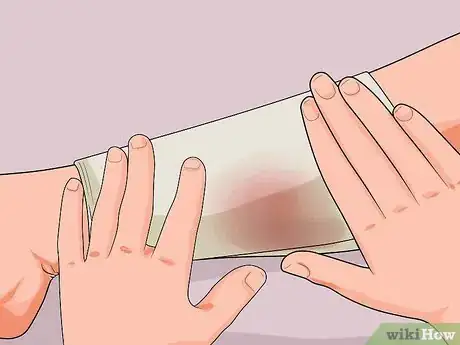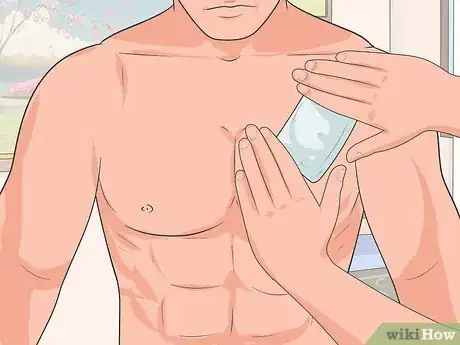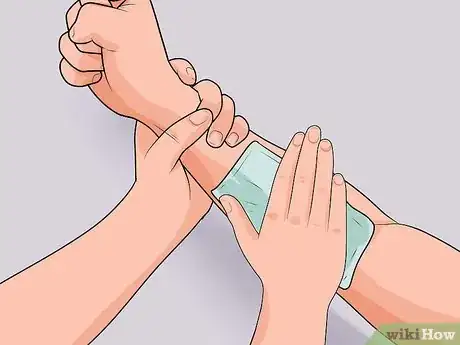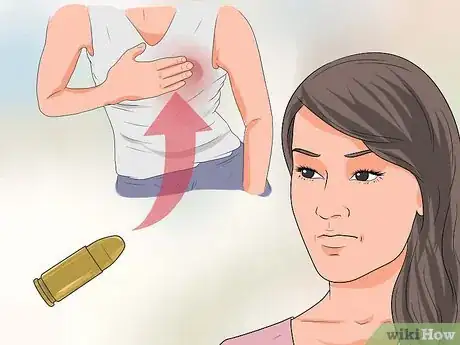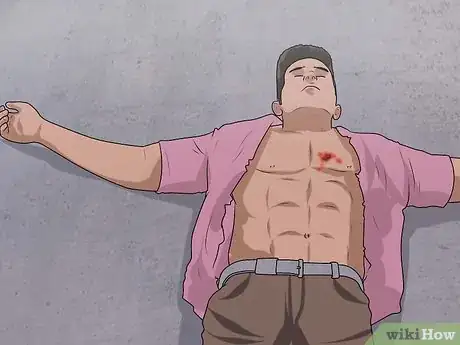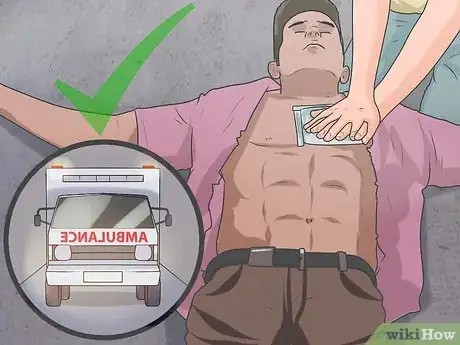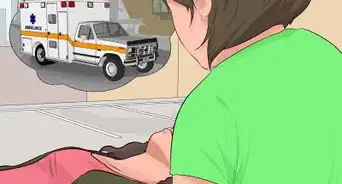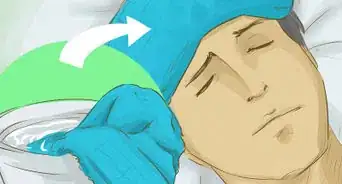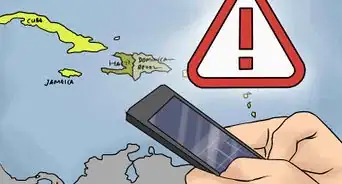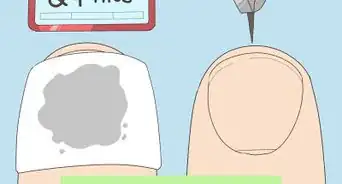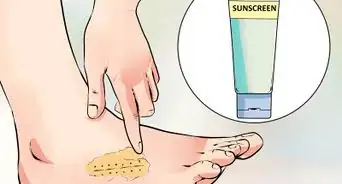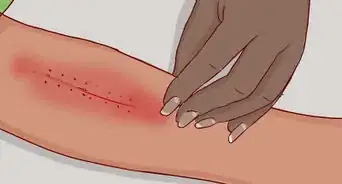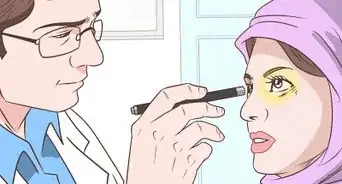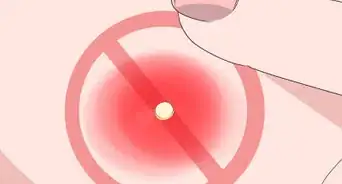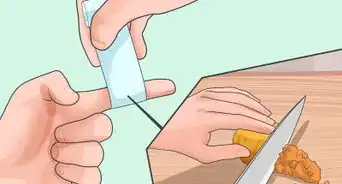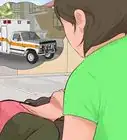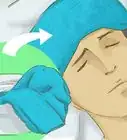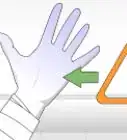This article was medically reviewed by Danielle Jacks, MD. Danielle Jacks, MD is a Surgical Resident at Ochsner Clinic Foundation in New Orleans, Louisiana. She has over six years of experience in general surgery. She received her MD from Oregon Health and Science University in 2016.
There are 7 references cited in this article, which can be found at the bottom of the page.
wikiHow marks an article as reader-approved once it receives enough positive feedback. This article received 12 testimonials and 92% of readers who voted found it helpful, earning it our reader-approved status.
This article has been viewed 932,178 times.
Gunshot wounds are one of the most traumatic injuries you can suffer. It's difficult to assess the extent of damage done by a gunshot wound, and it typically far exceeds what you can reasonably treat with first aid. For this reason, the best option is to get the victim to a hospital as soon as possible. However, there are some first aid measures that you can take before professional assistance arrives.
Steps
Providing Basic First Aid
-
1Establish that you are in a safe position. If the victim was shot unintentionally (such as while hunting), make sure that everyone's firearm is pointed away from others, cleared of ammo, safe, and secured. If the victim was shot in a crime, verify that the shooter is no longer on the scene and that both you and the victim are safe from further injury. Wear personal protective equipment, such as latex gloves, if available.
-
2Call for help. Dial 911 for emergency medical assistance. If you are calling from a cell phone, be certain that you can provide the operator with your location. The operator will have difficulty locating you otherwise.[1]Advertisement
-
3Keep the victim in place. Do not move the victim unless you must do so to keep him safe or access care. Moving the victim could aggravate a spinal injury. Elevating the wound can limit bleeding, but should not be considered unless you are confident that there is no spinal injury.
-
4Act quickly. Time is your enemy in treating the victim. Victims who reach medical facilities during the "Golden Hour" have a much better likelihood of surviving. Try to keep your movements swift without making the person feel more upset or panicked.
-
5Apply direct pressure to control bleeding. Take cloth, bandage, or gauze and press directly against the wound using the palm of your hand. Continue for at least ten minutes. If bleeding does not stop, check the location of the wound and consider re-positioning yourself.[2] Add new bandages over the old; do not remove bandages when they become soaked. [3]
-
6Apply dressing. If the bleeding subsides, apply cloth or gauze to the wound. Wrap it around the wound to apply pressure. Do not, however, wrap so tightly that the victim loses circulation or feeling in her extremities.[4]
-
7Be prepared to treat the victim for shock. Gunshot wounds frequently lead to shock, a condition caused by trauma or loss of blood. Expect that a gunshot victim will show signs of shock and treat them accordingly by making sure the victim's body temperature remains consistent — cover the person so that he does not get cold. Loosen tight clothing and drape him in a blanket or coat. Typically you would want to elevate the legs of someone experiencing shock, but refrain from doing so if they might have a spinal injury or a wound in the torso.[5]
-
8Give reassurance. Tell the person that she's okay and that you're helping. Reassurance is important. Ask the person to talk to you. Keep the person warm.
- If possible, ask the person about any medications she is taking, any medical conditions (i.e. diabetes, hypertension), and any drug allergies she may have. This is important information and may distract her from her wound.
-
9Stay with the person. Continue to reassure and keep the victim warm. Wait for the authorities. If the blood congeals around the bullet wound, do not remove blood mats on wound, as this may be limiting blood loss.
Assessing the Victim's Status
-
1Remember the A, B, C, D, E's. For advanced treatment it is important to consider the status of the person. A, B, C, D, E is an easy way to remember the important factors you should consider. Assess these five critical factors to see what sort of assistance the victim requires.
-
2Check the airway. If the person is talking, his airway is probably clear. If the person is unconscious, check to make sure that his airway is not obstructed. If it is and there is no spine injury, perform a head tilt.[6]
- Apply gentle pressure to the forehead with the palm of one hand, while placing the other under the chin and using it to tilt the head back.
-
3Monitor breathing. Is the victim taking regular breaths? Can you see her chest rising and falling? If the victim is not breathing, start rescue breathing immediately.
-
4
-
5Look for a disability. Disability refers to damage to the spinal cord or neck. Check to see if the victim can move his hands and feet. If not, there may be an injury to the spinal cord. Look for compound or obvious fractures, dislocations, or anything that looks out of place or unnatural. If the victim shows signs of disability, you should refrain from moving him or her.
-
6Check for exposure. Look for an exit wound. Check the victim as thoroughly as possible for other wounds that you may be unaware of. Pay special attention to the armpit, buttocks or other difficult-to-see areas. Avoid completely undressing the victim before emergency help arrives as this may advance shock.
Treating a Wound in the Arms or Legs
-
1Elevate the limb and apply direct pressure to the wound. Carefully assess the situation to determine that there is no sign of disability or any wounds that would suggest the victim sustained a spinal injury. If this is the case elevate the limb above the heart to reduce blood flow. Apply direct pressure to stop bleeding as described above.
-
2Apply indirect pressure. In addition to direct pressure, it is also possible to apply indirect pressure for limb injuries to limit the blood flow to the wound. This is done by putting pressure on arteries or, as they are sometimes called, pressure points. They will feel like particularly large and hard veins. Applying pressure to them will limit internal bleeding, but you need to apply pressure to verify that the artery applies to the wound. [7]
- To slow blood flow to the arm, press on the brachial artery on the inner side of the arm, opposite the elbow.
- For groin or thigh injuries, apply pressure to the femoral artery, between the groin and the upper thigh. This one is particularly large. You will have to use the entire heel of your hand to reduce circulation.
- For lower leg wounds, apply pressure to the popliteal artery, behind the knee.
-
3Make a tourniquet. The decision to apply a tourniquet should not be taken lightly because it might result in loss of limb. But if the bleeding is extremely severe and you have bandage or fabric on hand you can, consider making a tourniquet.
- Wrap bandage tightly around the limb, between the wound and the heart, as close to the wound as possible. Wrap around limb several times and tie a knot. Leave enough fabric to tie a second knot around a stick. Twist stick to restrict blood flow.[8]
Treating a Sucking Chest Wound
-
1Recognize a sucking chest wound. If a bullet has penetrated the chest, it is possible that a sucking chest wound exists. Air is coming in through the wound, but not coming out, collapsing the lung. Signs of a sucking chest wound include a sucking sound emanating from the chest, coughing up blood, frothy blood coming from the wound, and shortness of breath. When in doubt, treat the wound as a sucking chest wound.[9]
-
2Find and expose the wound. Look for the wound. Remove clothes from wound. If some fabric is stuck to the wound, cut around it. Determine if there is an exit wound and if so apply procedure to both sides of the victim’s wound.
-
3Seal the wound on three sides. Take airtight material, plastic is best, and tape it around the wound, covering all sides except for the bottom corner. Oxygen will escape from this hole.[10]
- As you seal the wound, encourage the patient to completely exhale and hold his or her breath. This will force air out of the wound before you seal it.[11]
-
4Apply direct pressure to both sides of the wound. It is possible to do this with two pads over each wound, held very tightly in place by a wrapped bandage.
-
5Carefully monitor the patient's breathing. You can do this by talking to the conscious patient, or watching the chest rise and fall.
- If there is evidence of respiratory failure (stopping breathing), reduce pressure on the wound to allow the chest to rise and fall.
- Prepare to perform rescue breathing.
-
6Do not release pressure or remove the seal when medical assistance arrives. They will either use your seal or replace it with a better one.
Expert Q&A
-
QuestionCan the wounds be cleaned with water? Or should I use peroxide?
 Jonas DeMuro, MDDr. DeMuro is a board certified Pediatric Critical Care Surgeon in New York. He received his MD from Stony Brook University School of Medicine in 1996. He completed his fellowship in Surgical Critical Care at North Shore-Long Island Jewish Health System and was a previous American College of Surgeons (ACS) Fellow.
Jonas DeMuro, MDDr. DeMuro is a board certified Pediatric Critical Care Surgeon in New York. He received his MD from Stony Brook University School of Medicine in 1996. He completed his fellowship in Surgical Critical Care at North Shore-Long Island Jewish Health System and was a previous American College of Surgeons (ACS) Fellow.
Board Certified Critical Care Surgeon The wound from a bullet is actually the least of your concerns, as the bullet is essentially sterile from coming out of the gun with the gunpowder. The real issue is the damage to the structures beneath the bullet wound, and these are potentially serious issues. Therefore, the wound needs to be seen immediately in the ED by a team of physicians that have experience with trauma.
The wound from a bullet is actually the least of your concerns, as the bullet is essentially sterile from coming out of the gun with the gunpowder. The real issue is the damage to the structures beneath the bullet wound, and these are potentially serious issues. Therefore, the wound needs to be seen immediately in the ED by a team of physicians that have experience with trauma. -
QuestionWhat do you do if the bleeding doesn't stop or slow after 20 minutes of applied pressure, bandages etc.?
 Jonas DeMuro, MDDr. DeMuro is a board certified Pediatric Critical Care Surgeon in New York. He received his MD from Stony Brook University School of Medicine in 1996. He completed his fellowship in Surgical Critical Care at North Shore-Long Island Jewish Health System and was a previous American College of Surgeons (ACS) Fellow.
Jonas DeMuro, MDDr. DeMuro is a board certified Pediatric Critical Care Surgeon in New York. He received his MD from Stony Brook University School of Medicine in 1996. He completed his fellowship in Surgical Critical Care at North Shore-Long Island Jewish Health System and was a previous American College of Surgeons (ACS) Fellow.
Board Certified Critical Care Surgeon Any bullet wound should be seen immediately, as this is a medical emergency. Any delay easily means the difference between life and death in many cases. It is fine to apply pressure (with appropriate safety precautions, including gloves and eye/mouth protection) while waiting for the ambulance to arrive after calling 9-1-1.
Any bullet wound should be seen immediately, as this is a medical emergency. Any delay easily means the difference between life and death in many cases. It is fine to apply pressure (with appropriate safety precautions, including gloves and eye/mouth protection) while waiting for the ambulance to arrive after calling 9-1-1. -
QuestionHow can I treat non-fatal headshots?
 Danielle Jacks, MDDanielle Jacks, MD is a Surgical Resident at Ochsner Clinic Foundation in New Orleans, Louisiana. She has over six years of experience in general surgery. She received her MD from Oregon Health and Science University in 2016.
Danielle Jacks, MDDanielle Jacks, MD is a Surgical Resident at Ochsner Clinic Foundation in New Orleans, Louisiana. She has over six years of experience in general surgery. She received her MD from Oregon Health and Science University in 2016.
Surgical Resident A gunshot to the head always needs to be treated at a hospital, even if it didn't enter the skull. It's still possible that the person's skull is fractured or that there's bleeding inside the person's brain. Get emergency medical care at a hospital.
A gunshot to the head always needs to be treated at a hospital, even if it didn't enter the skull. It's still possible that the person's skull is fractured or that there's bleeding inside the person's brain. Get emergency medical care at a hospital.
Warnings
- Avoid blood-borne illnesses. Make sure any open wounds you may have do not come in contact with the victim's blood.⧼thumbs_response⧽
- Even with the best first aid, gunshot wounds may be fatal.⧼thumbs_response⧽
- Do not put your own life at risk when treating a gunshot victim.⧼thumbs_response⧽
References
- ↑ http://www.nbcnews.com/tech/security/why-calling-911-your-cell-not-always-good-idea-n99736
- ↑ http://danger.mongabay.com/gunshot_wound_bleeding.htm
- ↑ http://www.patient.info/showdoc/40001334
- ↑ http://danger.mongabay.com/gunshot_wound_bleeding.htm
- ↑ http://www.mayoclinic.org/first-aid/first-aid-shock/basics/art-20056620
- ↑ http://www.healthline.com/human-body-maps/brachial-artery
- ↑ http://danger.mongabay.com/gunshot_wound_bleeding.htm
- ↑ http://danger.mongabay.com/gunshot_wound_bleeding.htm
- ↑ http://www.armystudyguide.com/content/powerpoint/First_Aid_Presentations/apply-a-dressing-to-an-op-5.shtml
About This Article
To treat a bullet wound, don't move the person and call 911 immediately for emergency medical assistance. While you're waiting for them to arrive, apply direct pressure over the wound with a cloth, bandage, or gauze to control bleeding. If the person was shot in the arm or leg, elevate the limb as you apply pressure. Keep talking to the person, reassuring them that everything is going to be okay and help is on the way. The person will probably start feeling cold, which is common, so cover them with a blanket or your jacket to keep them warm until the medical team arrives. For specific tips on dealing with a chest wound, read on!




